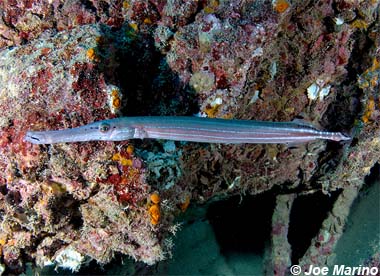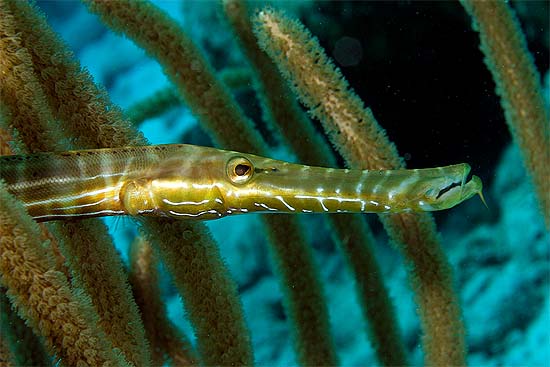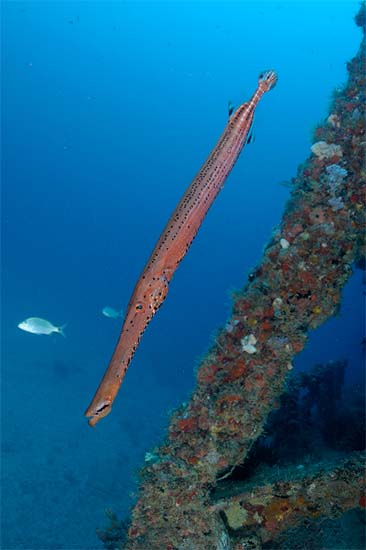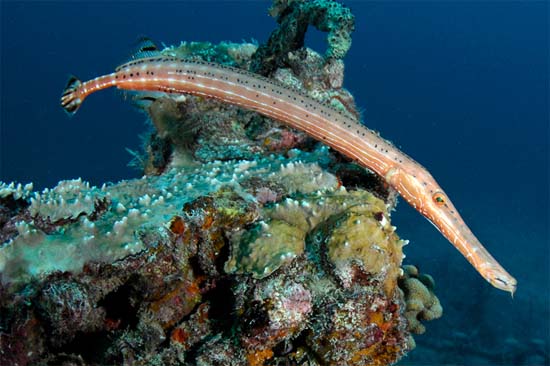Trumpetfish

Aulostomus maculatus
These elongated masters of camouflage usually grow to be 24 to 36 inches long, and float head down among coral, rapidly changing color as needed to blend in. They ambush their prey, and can open their mouths to the diameter of their bodies to suck food in quickly.
Order – Syngnathiformes
Family – Aulostomidae
Genus – Aulostomus
Species – maculatus
Common Names
English language common names include trumpetfish, Atlantic trumpetfish, Caribbean trumpetfish, fifer, and trumpet fish. Other common names are corneta (Spanish), gefleckter trompetfisch (German), peixe-trombeta (Portuguese), plettet trompetfisk (Danish), trombeta (Portuguese), trompa (Spanish), trompet (Papiamento), trompet del Atlantico (Spanish), trompeta pintada (Spanish), trompetero (Spanish), trompette (French), trompette tachetée (French), trompetvis (Dutch), trumpetfisk (Swedish), tròmpèt (Papiamento), and trõmpet lame (Creole/French).
Importance to Humans

Although not of commercial importance, the trumpetfish is caught incidentally throughout its range in seines and traps. It is marketed locally for human consumption. It is also a popular display fish at public aquariums due to its in interesting body shape and habits.
Conservation
The trumpetfish has not been evaluated by the World Conservation Union (IUCN). The IUCN is a global union of states, governmental agencies, and non-governmental organizations in a partnership that assesses the conservation status of species.
Geographical Distribution

The trumpetfish fish resides in the western Atlantic Ocean from off southern Florida and Bermuda, south to the northern coast of South America. In the eastern Atlantic, this species is found off St. Paul’s Rocks.
Habitat
Commonly found in close proximity to coral reefs, trumpetfish often swim vertically with their snouts down helping them blend in with sea fans, pipe sponges and sea whips. They range from 7-82 feet (2- 25 m) in depth.
Biology
Distinctive Features
The body of the trumpetfish is very elongate and somewhat compressed with a strongly compressed head. The snout is very long with a trumpet-like mouth. There is a prominent barbel located on the chin at the tip of at the lower jaw. The dorsal and anal fins are set far back on the body with a series of 8-12 dorsal spines preceding the soft dorsal fin. The soft dorsal fin is located opposite of the anal fin. The caudal fin is rounded.

Coloration
The most common coloration phase of the trumpetfish is mottled brown to reddish brown with irregular black or brown spots. It may also sometimes appear blue-gray, bright yellow or green and can change its color to camouflage with its surroundings with ease. There are silvery streaks along the head and the sides of the body. There is a black bar at the base of the dorsal and anal fins although this bar may occasionally be reduced to a spot. The caudal fin may have one or two spots.
Dentition
Although there are tiny teeth on the lower jaw, there are no teeth present on the upper jaw
Size, Age, and Growth
The maximum reported length of the trumpetfish is 39.4 inches (100cm) total length (TL). This species is more commonly observed at approximately 23.6 inches (60cm) TL.
Food Habits
Known to use large herbivorous fish as camouflage, the trumpetfish will shadow them until the right moment to strike presents itself. Another strategy is to hang vertically among gorgonians or drifting with the current, ambushing any prey items that swim beneath it through a sucking action. The trumpetfish’s mouth has elastic tissues that allow it to open to the diameter of the body, creating a vacuum for sucking up small animals as well as those larger than the trumpetfish’s mouth. Documented prey items include the ocean surgeon (Acanthurus bahianus), blue chromis (Chromis cyanea), tomtate (Haemulon aurolineatum), French grunt (Haemulon flavolineatum), longspine squirrelfish (Holocentrus rufus), downy blenny (Labrisomus kalisherae), dusky blenny (Malacoctenus gilli), redlip blenny (Ophioblennius atlanticus), rusty goby (Priolepis hipoliti), spotted goatfish (Pseudupeneus maculatus), reef squirrelfish (Sargocentron coruscum), yellowtip damselfish (Stegastes pictus), and bluehead (Thalassoma bifasciatum).
Reproduction
Trumpetfish courtship includes an elaborate courtship ritual or “dance” along with changes in coloration.

Predators
Reported predators of trumpetfish include the coney (Cephalopholis fulva), yellowfin grouper (Mycteroperca venenosa), red hind (Epinephelus guttatus), dog snapper (Lutjanus jocu), and schoolmaster (Lutjanus apodus).
Parasites
Scientific studies have documented the copepods Caligus atromaculatus and Caligus biaculeatus as parasites of the trumpetfish.
Taxonomy
The trumpetfish was originally described as Aulostomus maculatus by Valenciennes in 1841. There are no known synonyms appearing in past scientific literature referring to this species; however Aulostoma maculatus and Aulostomus maculatum are both considered misspellings of the valid scientific name. There is only a single genus consisting of three species within the family Aulostomidae. The family and genus names are derived from the Greek “auls” meaning flute and “stoma” meaning mouth. This name is in reference to the tubular snouts that members of this family and genus possess. The species name maculatus is derived from the Latin word “macula” meaning spot.
Prepared by: Cathleen Bester